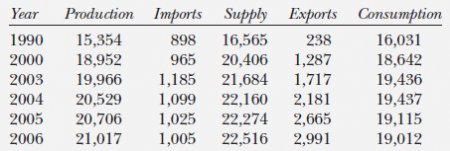Pork industry
Definition: Enterprises that breed, raise, and slaughter pigs, process them into food products, and market and distribute those products
Significance: Pork, ham, bacon, and other pork products have been consistent parts of the American diet through most of the nation’s history, particularly among lower-income groups, for which they represent affordable sources of protein.
The first domestic pigs were brought to the Americas by Christopher Columbus on his second voyage of exploration (1493-1499). Subsequent Spanish explorers brought more swine, some of which escaped their keepers and reverted to a feral form not dissimilar to wild boars. These feral hogs became the ancestors of the razorbacks of the Ozarks.
Early English settlers in Virginia and Massachusetts also brought domestic hogs during the seventeenth century. Typically, these hogs were allowed to roam in the woods around a settlement, eating acorns and other wild foods and turning them into edible flesh. Alternatively, they could be kept in pens within farmsteads, in which case they were generally fed table scraps (slops). In areas where no good roads existed to take wagonloads of grain to market, corn was often fed to hogs, which were subsequently walked to market themselves. Because hogs ate such a wide variety of feed and their flesh could easily be preserved by salting, pork was generally the cheapest type of meat available in America. As a result, the diet of lower-income Americans was often heavy in salt pork.
By the second half of the nineteenth century, there was an increasing interest in improving hog breeds. This period marked the development of all the modern hog breed books, which keep records of purebred stock. The modern meatpacking industry also developed at this time, centered in such cities as Cincinnati and Chicago. Indeed, Chicago turned so many hogs into canned and frozen cuts of meat that poet Carl Sandburg would call the city “hog butcher to the world.” In Chicago’s huge slaughterhouses and packing plants, the process of reducing a hog carcass to processed meat was systematized so that one carcass after another passed men with knives, each of whom removed a particular part. This “disassembly line” was so efficient that it may have inspired the assembly lines with which Henry Ford made the Model T affordable to ordinary workers.
Pork Supply and Use, 1990-2006, in Millions of Pounds
Source: Data from the Statistical Abstract of the United States, 2008 (Washington, D.C.: Department of Commerce, Economics and Statistics Administration, Bureau of the Census, Data User Services Division, 2008)
Note: Weight is the weight of the animal minus entrails, head, hide, and internal organs but with fat and bone. Total supply equals production plus imports plus remaining stocks of previous year.
The packing plants were also a driving force of social change. They employed enormous numbers of immigrants, often in appalling conditions. Upton Sinclair’s 1906 novel The Jungle, which exposed the conditions in which these people lived and worked, led to the passage of the Pure Food and Drug Act of 1906 and the beginnings of modern regulation of food safety.
In the twentieth century, hog farming became an increasingly specialized business. Hogs were raised in confinement buildings, often in vast numbers. Some hog farms were so large that the management of the resulting waste was a serious environmental issue, and neighbors began to fight the construction of these “pork factories.” Confinement also attracted criticism from animalrights advocates, who regarded it as cruel and argued that it induced deleterious changes in the behavior of hogs.
Leigh Husband Kimmel
Further Reading
Pont, Wilson G., and Katherine A. Houpt. The Biology of the Pig. Ithaca, N.Y.: Comstock, 1978.
Rath, Sara. The Complete Pig: An Entertaining History of Pigs. Stillwater, Minn.: Voyageur Press, 2000.
Watson, Lyall. The Whole Hog: Exploring the Extraordinary Potential of Pigs. Washington, D.C.: Smithsonian Books, 2004.
See also: agribusiness; agriculture; Beef industry; commodity markets; Fishing industry; Food and Drug Administration; Food-processing industries; The Jungle; Meatpacking industry; Poultry industry.


